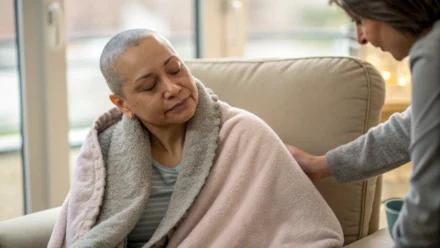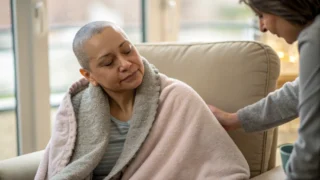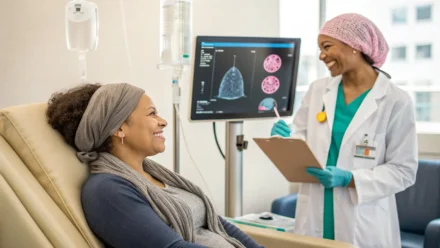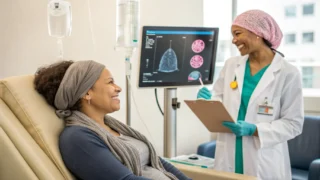I’m Dr. Jennifer Griggs and in this article I’ll walk you through the treatment options for stage I breast cancer in clear, practical terms. I created a video on this topic for Yerbba – Breast Cancer to help people understand what “stage I” means, what to expect from surgery, radiation, chemotherapy, endocrine (hormonal) therapy and targeted therapy, and how decisions are made. Below I expand on those points so you can use this as a reference while talking with your care team.
Overview: What is Stage I Breast Cancer?
Stage I breast cancer is an early, invasive cancer. That word “invasive” means cancer cells have grown into surrounding breast tissue, but the disease is small and the prognosis is generally excellent. Clinically and pathologically, stage I has two main defining features:
- The primary tumor is 2 centimeters (cm) or smaller in greatest dimension. To put that in perspective, 2 cm is less than an inch (1 inch ≈ 2.54 cm).
- EITHER there are no positive lymph nodes, OR there is only very small lymph node involvement—what we call micrometastasis—measuring less than 2 millimeters (mm).
It’s important to understand the difference between clinical stage (what we know before surgery based on exam and imaging) and pathologic stage (what the surgical pathology report shows after the tumor and possibly lymph nodes are removed). These can differ, and treatment decisions are often refined after pathologic results are available.
Step-by-step: From Diagnosis to Treatment Planning
When you first present with a breast lump or imaging abnormality, your clinical team will evaluate the breast and the lymph nodes in the axilla (armpit). Imaging may include a diagnostic mammogram and ultrasound; sometimes MRI is used, although it isn’t necessary in every case.
If the tumor and lymph nodes fit the criteria for clinical stage I, the next usual step is surgery. The type and extent of surgery, the findings on the surgical pathology report, and tumor biology will guide the adjuvant (post-surgical) treatment plan.
Surgery: Lumpectomy vs Mastectomy and Sentinel Lymph Node Biopsy
For most women with stage I breast cancer, breast-conserving surgery (lumpectomy) is an option. A lumpectomy removes the tumor along with a rim of normal tissue around it (a margin). Alternatively, some patients opt for mastectomy (removal of the entire breast). Both choices can be appropriate depending on patient preference, tumor location and size relative to breast size, genetic considerations, prior radiation, or other medical factors.
During surgery we usually evaluate the lymph nodes with a sentinel lymph node biopsy. The sentinel nodes are the first lymph nodes that drain the breast. To identify them, the surgeon injects either a blue dye, a radioisotope, or both near the tumor. The nodes that take up the dye or tracer are removed (usually 1–3 nodes) and examined closely by pathology.
If those sentinel nodes are negative for cancer, no further lymph node surgery is required. If they contain small deposits (micrometastases <2 mm), the situation is often still considered stage I and the surgeon’s approach to additional axillary surgery will depend on multiple factors.
Radiation Therapy After Lumpectomy
If you retain the breast after a lumpectomy, radiation therapy to the whole breast is the standard of care. The purpose of radiation is to reduce the chance the cancer will return in the breast. Radiation is usually given after surgery (and often after chemotherapy if chemotherapy is part of the plan).
Typical schedules
- Conventional: once a day, five days a week, for about six weeks, often followed by a “tumor bed boost” (a few extra treatments focused on the area where the tumor was removed).
- Hypofractionation / accelerated schedules: higher dose per day for fewer total treatments (shorter overall duration). Many centers now routinely offer shorter courses that are as effective and safe for eligible patients.
- Accelerated hyperfractionation: treatment given twice a day over a shorter time period — less common but offered in specific settings.
Ask your radiation oncologist what fractionation schedule they recommend and whether you are a candidate for a shorter course.
What radiation feels like and what to expect
Let me be very clear about a couple of common worries:
“Radiation treatment does not make you radioactive.”
You will not make other people or food radioactive; you can be around pregnant people and children without concern. The most common acute side effects are:
- Skin changes similar to a sunburn (redness, tenderness) that usually start a couple of weeks into treatment and improve within a few weeks after finishing.
- Fatigue that often builds over the course of treatment and typically improves in the weeks following completion.
- Local changes in the treated breast such as temporary swelling, skin color changes, or the development of small skin tags that may later slough off; most changes fade with time.
The radiation planning session—called a simulation—takes longer than a daily treatment. During simulation you will lie comfortably on a planning device with your arm up (a cradle) while a CT scan is used to map your anatomy and help the team design a plan that avoids the heart and lungs while targeting the breast tissue. This planning step can take a couple of hours; daily treatments afterward are quick (around 15–20 minutes), so most people drive themselves to and from the appointment and resume normal activities afterward.
Chemotherapy for Stage I Breast Cancer: Why and When
Chemotherapy in early-stage breast cancer is used as adjuvant treatment—that is, to lower the chance that microscopic cancer cells that have already escaped the breast (but are too small to see on scans) will grow into a recurrence elsewhere in the body. We give chemotherapy as a preventive measure to improve the chance of cure.
How we decide whether chemotherapy is needed
Chemotherapy is not recommended for every person with stage I disease. The decision depends primarily on tumor biology and other risk features, not just stage. Key factors that influence this decision include:
- Hormone receptor status (estrogen receptor [ER] and progesterone receptor [PR]). ER-negative tumors are more likely to benefit from chemotherapy.
- HER2 status. HER2-positive tumors commonly receive targeted therapy (trastuzumab), and chemotherapy is usually part of that treatment plan.
- Tumor grade. Higher grade (grade 3) tumors are more aggressive and more likely to prompt chemotherapy recommendations.
- Molecular/tumor genomic assays. Tests such as Oncotype DX, MammaPrint, and Prosigna (PAM50) can estimate the likelihood of recurrence and the potential benefit from chemotherapy by producing a recurrence score or risk category.
These genomic assays typically report a low, intermediate, or high recurrence risk. A high recurrence score suggests a higher chance of recurrence and a greater potential benefit from chemotherapy; a low score usually means chemotherapy offers little additional benefit. Your care team will review these results with you in context of your age, overall health, and preferences.
Special histologies that usually don’t need chemotherapy
Some tumor types have an excellent prognosis and typically don’t benefit from chemotherapy, even if the tumor is small or larger. Two such types are:
- Tubular carcinoma
- Mucinous (colloid) carcinoma
For these histologies, genomic assays usually don’t change management and chemotherapy is generally not given.
How chemotherapy is given and practical details
Chemotherapy is most often administered intravenously (into a vein). Options include:
- Peripheral IV in the arm for each treatment session.
- A central venous port (small device placed under the skin) if veins are difficult to access or multiple cycles are planned. Ports require a minor procedure to place, so we try to avoid them if possible.
Before chemotherapy you’ll receive anti-nausea medications (antiemetics) by mouth and/or IV to reduce the chance of nausea and vomiting. Many of these medications have greatly improved comfort during and after chemotherapy, but you should always call your care team if you are having significant symptoms between visits so dosing can be adjusted.
Common side effects and how to prepare
Side effects vary by regimen, but the ones most patients experience include:
- Fatigue: Chemotherapy fatigue can be profound. Be kind to yourself, plan rest, and enlist help for chores and transportation when needed.
- Hair thinning or loss: The most effective curative chemotherapy regimens often cause significant hair thinning or complete hair loss. Anticipating this and preparing (wigs, scarves, head coverings) can make the experience easier emotionally.
- Nausea: Usually well-controlled with modern antiemetics, but call if nausea is not controlled.
- Other regimen-specific effects: These can include neuropathy (tingling in hands/feet), low blood counts (risk of infection or bleeding), mouth sores, and more. Your oncology nurse will explain the anticipated side effects for your specific regimen.
In terms of scheduling and duration, chemotherapy regimens differ. Some last a few months with cycles every 2–3 weeks; others are shorter or longer. Your oncologist will explain the specific schedule for your regimen.
If cost is a concern, talk to your care team and billing office—financial counselors can help access assistance programs, and many antiemetic and supportive medications are covered by insurance or available through patient assistance programs.
Targeted Therapy for HER2-Positive Tumors
If your tumor overexpresses HER2 (HER2-positive), targeted therapy with trastuzumab (brand name Herceptin, and biosimilars) is typically recommended. About 1 in 5 breast cancers is HER2-positive.
How trastuzumab is given and what to expect
- Trastuzumab is usually administered intravenously, although subcutaneous formulations are available in some settings and can shorten clinic time.
- Treatment typically continues for one year in the adjuvant setting as long as you tolerate it well.
- Trastuzumab is generally well tolerated; many people find side effects minimal compared with chemotherapy.
- Rarely, trastuzumab can affect heart function, so we monitor cardiac function (usually with echocardiogram or MUGA scans) during treatment. If heart function declines, we may pause or stop trastuzumab temporarily or permanently depending on the situation.
Trastuzumab is often started alongside chemotherapy or after chemotherapy depending on the chemotherapy regimen. Because it is commonly given with chemo, some side effects people attribute to trastuzumab are actually due to the chemotherapy component. One encouraging point for patients receiving trastuzumab is that hair often begins to grow back even while trastuzumab continues—an emotionally meaningful milestone for many.
Endocrine (Hormonal) Therapy for ER/PR-Positive Tumors
If your tumor expresses hormone receptors (ER and/or PR), endocrine therapy is a cornerstone of treatment. These medications reduce estrogen’s ability to stimulate any remaining cancer cells and substantially lower the risk of recurrence.
Common endocrine therapy options
- Tamoxifen: A selective estrogen receptor modulator commonly used in premenopausal women and in some postmenopausal women. Taken as a daily pill.
- Aromatase inhibitors (AIs): Examples include anastrozole, letrozole, and exemestane. These drugs lower estrogen levels made by non-ovarian tissues (adipose, muscle, etc.) and are effective only if ovarian function has ceased (naturally or through suppression). AIs are generally used in postmenopausal women or combined with ovarian suppression in some premenopausal women.
- Ovarian suppression: For premenopausal women at higher risk, we may recommend medical ovarian suppression with LHRH agonist injections (e.g., goserelin) or surgical removal of the ovaries. Ovarian suppression is often combined with tamoxifen or an aromatase inhibitor for added benefit in certain patients.
Duration, side effects, and adherence
Endocrine therapy is given as a daily pill and is typically prescribed for 5 years, sometimes extended to 10 years depending on risk features and tolerance. These medications are extremely effective in ER-positive disease—often more influential than chemotherapy in preventing hormone-driven recurrences—so adherence is critical.
Common side effects include hot flashes, mood changes, sleep disturbances, joint aches (particularly with aromatase inhibitors), and bone density loss with aromatase inhibitors. Side effects often peak around 3 months after starting and may improve thereafter. If you’re struggling with side effects, don’t stop the medication without talking to your care team—we can help manage symptoms, consider switching agents, or evaluate bone health and provide supportive treatments.
Cost concerns are common but manageable. Most insurance plans cover endocrine therapy, and financial assistance programs exist for those who need help. Ask your oncology nurse or social worker for resources.
Putting It All Together: Personalized Decision-Making
Treatment for stage I breast cancer is highly personalized. Beyond tumor size and lymph node status, the biology of the tumor—ER/PR status, HER2 status, tumor grade, and genomic assay results—drives many decisions. Your age, menopausal status, general health, personal values and preferences, and worries about side effects or costs also matter.
Here is the typical flow of decision-making:
- Confirm pathology and tumor markers (ER/PR, HER2) and consider a genomic risk assay if applicable.
- Decide surgical approach (lumpectomy vs mastectomy) and complete sentinel lymph node biopsy at the time of surgery.
- If breast-conserving surgery performed, plan for adjuvant radiation to the breast.
- Based on tumor biology and risk, decide whether chemotherapy is likely to provide benefit.
- If HER2-positive, plan for trastuzumab for about a year (often with chemotherapy).
- If ER-positive, plan endocrine therapy for 5–10 years, with decisions about ovarian suppression as appropriate for premenopausal patients.
Questions to Ask Your Team
Going into appointments with a set of questions can help you feel more in control. Here are practical questions to consider:
- What is my clinical stage and what did the surgery/pathology report show?
- Is my tumor ER/PR-positive, HER2-positive, or triple negative?
- Should I get a genomic tumor assay (e.g., Oncotype DX, MammaPrint, Prosigna)? If so, how will the result influence chemotherapy decisions?
- Am I a candidate for breast-conserving surgery and radiation? If I choose mastectomy, will I still need radiation?
- Do you recommend chemotherapy for me? What specific regimen? What are the expected benefits and risks?
- If my tumor is HER2-positive, how will trastuzumab be given and how will my heart be monitored?
- Which endocrine therapy do you recommend and for how long? Should we discuss ovarian suppression?
- What side effects should I expect from each treatment and how will they be managed?
- What financial resources or patient assistance programs are available if I’m concerned about costs?
- Are there clinical trials that might be appropriate for me?
Practical Tips for Managing Treatment
- Plan for fatigue: prioritize sleep, ask for help with household tasks, and conserve energy for important activities.
- Prepare for hair changes: look into wigs or scarves, or consider head coverings ahead of time so you have options when hair thinning begins.
- Keep a symptom diary: write down side effects, their severity, and timing to share with your care team—it helps them adjust supportive medications promptly.
- Ask about anti-nausea regimens and bring medications home if recommended so you don’t have to wait to feel better.
- Attend scheduled cardiac monitoring if you’re on trastuzumab and bone density checks if on aromatase inhibitors.
- Discuss fertility and contraception with your oncologist if you are premenopausal and want future children—chemotherapy and ovarian suppression can affect fertility.
Follow-up and Surveillance
After treatment completion, follow-up includes regular visits with your oncology and surgical teams and routine imaging—usually an annual mammogram for the remaining breast tissue. Surveillance is individualized based on initial tumor features and treatments received. Be aware of new symptoms and report them promptly.
Emotional and Practical Support
Even with an excellent prognosis, a diagnosis of breast cancer is life-changing and can bring anxiety, depression, and uncertainty. Use support services: social workers, oncology nurses, counselor or therapist experienced with cancer, support groups (in-person or online), and loved ones. Practical support—help with transportation, childcare, and finances—makes a real difference during treatment.
Key Takeaways
- Stage I breast cancer is early-stage invasive disease with a tumor 2 cm or smaller and either no lymph node involvement or only very small micrometastasis.
- Treatment is personalized and may include surgery (lumpectomy or mastectomy), sentinel lymph node biopsy, radiation (after lumpectomy), chemotherapy (based on tumor biology), trastuzumab for HER2-positive disease, and long-term endocrine therapy for ER/PR-positive tumors.
- Genomic assays can help refine chemotherapy decisions by estimating recurrence risk and potential chemotherapy benefit.
- Radiation is safe for others and commonly causes skin changes and fatigue that improve after treatment; simulation and planning are important steps before daily therapy.
- Chemotherapy can cause fatigue and hair loss; supportive medicines have improved nausea control and many side effects are manageable if reported early.
- Endocrine therapy is taken daily for several years and is highly effective—staying on therapy as much as possible is one of the most important things you can do to reduce recurrence risk.
- Ask questions, involve your care team in symptom management, and use available financial and emotional support resources.
Final Thoughts
I know this is a lot of information to absorb. My goal in explaining stage I breast cancer treatment is to give you a road map so that when you meet your surgeon, radiation oncologist and medical oncologist you can ask focused questions and feel confident participating in decisions that reflect your values and priorities.
If you want a personalized summary of your treatment options, resources such as the Yerbba report can help outline choices specific to your tumor characteristics and preferences. Wherever you are in your journey, lean on your care team and the people who care about you. Treatment for stage I breast cancer is highly effective, and most people do very well with appropriate, individualized care.
Be kind to yourself through this process, and don’t hesitate to ask your team for clarity, support, and help navigating logistics or costs. You don’t have to manage this alone.










Leave a Comment